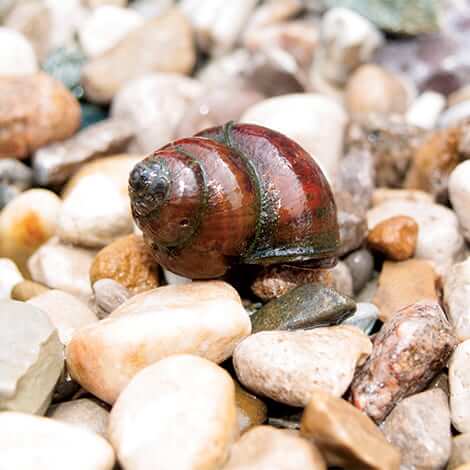Get ready to take notes, there will be a quiz at the end. Ok, so maybe there's not a quiz, but you might learn some things you never knew about Japanese Trapdoor Snails, also known by the scientific name Viviparis malleatus.
Snails are invertebrates called gastropods. They are scavenging herbivores that feed on algae and other organic debris. Japanese Trapdoor Snails get their name from the hinged fingernail-like plate that seals the shell's opening, offering protection from drought and predators. These snails are dark in color and vary greatly in size, but usually arrive to your door dime-sized. They are cold-weather tolerant, making them a perfect addition to most water gardens.
A Population of…
In order for these snails to have a positive effect on your water garden, we recommend a group – or escargatoire – of at least 10 snails per 50 square feet of pond. For a farm pond or larger feature, you will need at least 200 snails to have any effect at all. These snails naturally reproduce a few times throughout the year. They have 3-5 live young per birthing and will boost your population without overpopulating the pond as egg-bearing snails do.
What's in a Name?
Japanese Trapdoor Snails can be male or female. How do you know if you can name them Jack or Jill? Just take a look at the antennae. Antennae on females are the same size, whereas male have one that is shorter. This shorter antenna also doubles as a reproductive organ.
New Digs
After their travels, your snails will need a bit of time to get used to their new home. Just like fish, it is best to acclimate them slowly, especially in chilly early-season waters. Add some pond water to the bag and float or hold them in the water for a few minutes, out of direct sunlight. Once acclimated, leave them in a shallow area and let them work their way into the deeper sections of your pond. If they float, don't worry; air occasionally gets trapped in the shell. As long as the trapdoor is still in place, your snails are alive and the air will work its way out.
Home Sweet Home
Snails carry their home on their backs. If they feel threatened, they can disappear into their shells. When hungry, they will nibble on the algae, leaves, excess fish food, and other decaying matter. As with any aquatic critters, your snails need oxygen. Keep it flowing with an aeration kit, so your gastropods stay happy!
Hardier than the Average Snail
Though little, Japanese Trapdoor Snails can handle temperatures down to 0°F. Unlike other snails that use a snail's version of a snorkel to get air from outside the pond, Japanese Trapdoor Snails get oxygen from the water using their gills. Therefore, during winter they can stay in the warmer water at the bottom, rather than coming up to the frigid surface. As with fish and plants, snails cannot survive if the pond freezes solid; usually a depth of 20"-30" will provide a safe haven.
Hide and Seek
Sometimes, your snails will seem to disappear – especially in the spring and summer when the water gets warm. Snails camouflage into the rocks, gravel, and plants in their surroundings. Though it can be frustrating when they go incognito, do not worry. They will still be working hard, eating algae and keeping your pond clean. If you really need to see them, you can try placing a lettuce leaf in the pond. Within a few hours, your snails should gather around the lettuce.
Word of Caution
As invertebrates, snails can be killed by most algaecides. Please be sure to read any precautions and instructions on a chemical before using it in your pond. When provided by the manufacturer, we list this information in the Usage section on the product's webpage. Proactively managing your pond is important for the quality of your water, fish, and plants. For tips, check out our article Water Gardens 101.
